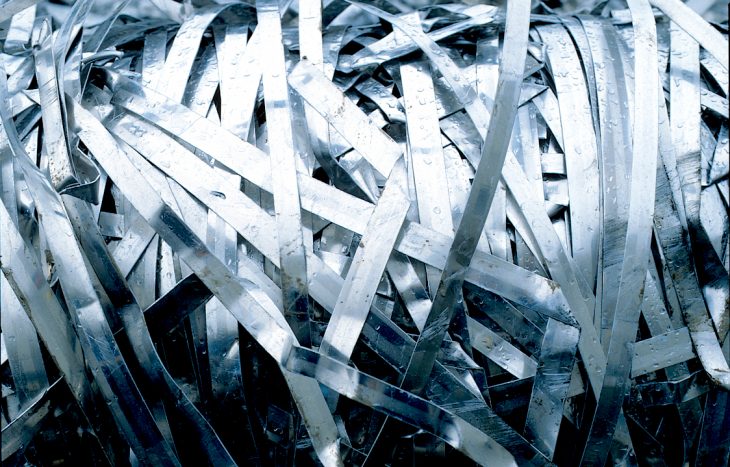By Gerd Krause, Mediakonzep.
At the end of their product life, cars, bicycles, beverage cans, rails, and bridges of closed down railway lines become valuable scrap material that can be separated by type, recycled, and then resurrected as consumer goods. Aluminum is one of the best enablers in an ecological recycling economy thanks to its infinitely recyclable characteristics. The period of time after which disused aluminum products return to the material cycle varies widely — a beverage can is only in circulation for a few weeks, while a car sometimes lasts twenty years and more.
Aluminum Recycling
Aluminum can practically be recycled endlessly. The recycling rate of aluminum without quality loss in the most important areas of use lies between 95 and 100%. One driver for aluminum use is lightweight construction, especially for cast parts in the automotive industry. “Whilst the worldwide production of cast iron materials has increased by a mere 50% since 1999, the output of aluminum casting has increased by a factor of more than two-and-a-half,” explained Büchner. As early as 2016, the global aluminum casting industry has achieved a new production record of just under 18 million tons. According to Büchner, the cast iron sector will benefit from part of the expected growth caused by the increased use of aluminum in automotive manufacturing.
In the long term, demand for aluminum will increase. Currently however, the increase in new capacities for primary aluminum is quite small. This is why Büchner assumes that there will only be a slight expansion of production opportunities in the next five years. However, additional growth is necessary in recycling aluminum production. “This indicates an accordingly higher demand for aluminum scrap,” concluded Büchner.
According to estimates by the International Aluminum Institute (IAI), in 2016 around 17 million tons of aluminum old scrap were accrued worldwide. This number will increase to around 21 million tons in 2020, according to the IAI. This corresponds to a share of more than a third of today’s global output of primary aluminum. Today, around 20% of our aluminum demand worldwide is covered by old scrap. Besides old scrap, new scrap is also generated. Some examples are cutting scrap in the production of semi-finished goods, sprues from casting foundries, and chips from the mechanical processing of semi-finished goods and products.
The amount of recycled metal is increasing. Aluminum companies such as Hydro continue to invest in the expansion of recycling capacities, utilizing new and improved processes to reduce emissions caused by melting aluminum scrap. With a production of around 700,000 tons, the German aluminum recycling industry is one of the leaders in Europe. In Germany, the production of aluminum made from scrap has far exceeded production using primary aluminum. The recycling rate has reached around 95% both in the automotive field and the construction sector and over 80% in packaging. Throughout Europe, close to 95% of aluminum scrap is also recycled from vehicles.
With regard to energy, aluminum manufacture using secondary aluminum is hard to beat: A mere 5% of the initial amount of energy used is required to manufacture aluminum from recycling material. In contrast, producing primary aluminum using bauxite/aluminum ore is extremely energy intensive. In Germany, the production of one ton of primary aluminum requires less than 15 MWh of electricity. In other countries, the required energy consumption can be considerably higher. The larger part of aluminum produced in Germany is made of secondary aluminum.
Scrap Supply
For the aluminum cycle of reusable materials, scrap supply is the bottleneck. Aluminum products can last for a very long time. Aluminum windows, for example, can reach a lifespan of sometimes far more than 50 years. Around 75% of all aluminum that was ever produced is still in use today. Part of this has already run through several recycling processes, according to aluminum manufacturer Hydro.
The recycling industry’s value chain consists of collection systems, dismantling companies, metal dealers, and scrap processors. “The supply situation on the scrap markets is satisfying,” says Dr. Heinz-Jürgen Büchner, managing director of Industrials & Automotive at IKB Deutsche Industriebank AG. For the time being, the trade dispute with the U.S. will not alter this fact. “Even before the punitive tariffs on aluminum became effective, the domestic price level on the metal market in the U.S. was considerably lower than that of the world market as well as that of the EU,” said Büchner. Therefore, it is expected that imports will continue to be profitable despite a surcharge of 25% import duty on steel and 10% on aluminum. “In addition, American aluminum processors have by and large passed on the price increases to the end customer.”
Editor’s Note: Exhibitors will present trends and developments in the scrap recycling industries at the METEC, GIFA, NEWCAST and THERMPROCESS trade fairs held concurrently at the exhibition center in Düsseldorf, Germany from June 25-29, 2019.

